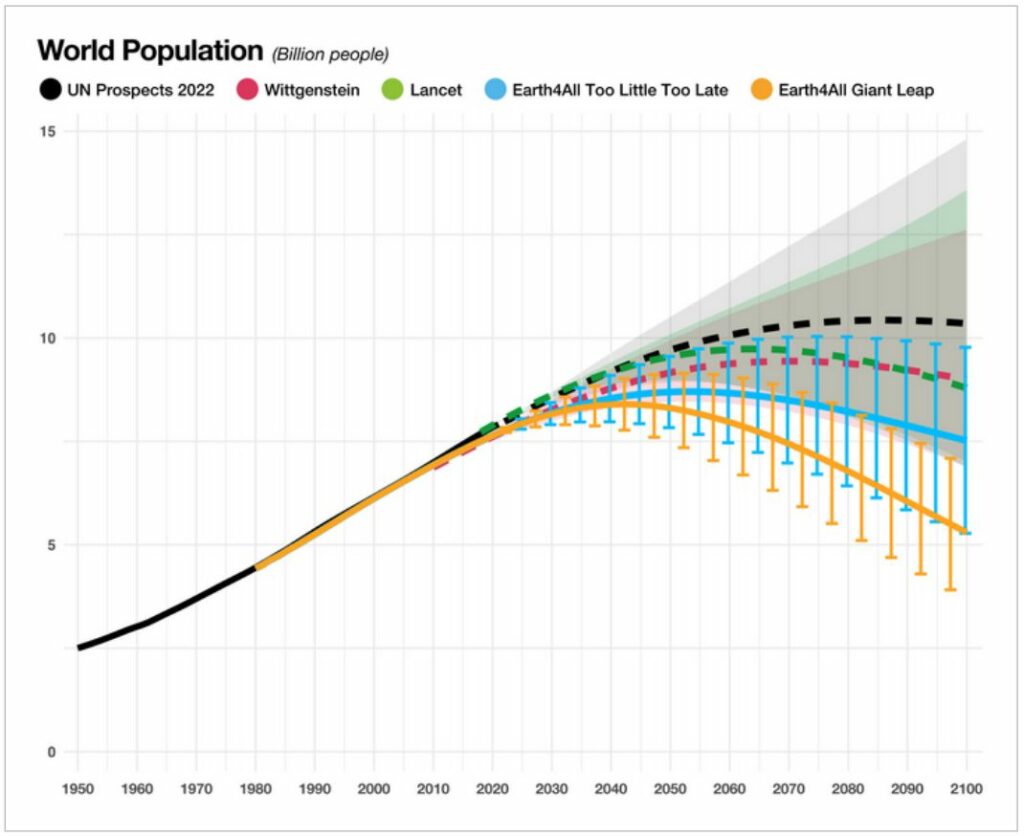Busting Population Myths: “A good life for all is only possible if the extreme resource use of the wealthy elite is reduced.”
A recent projection suggests that the global population may reach its peak in the mid-21st century below the 9 billion mark, which is significantly lower than previous prominent estimates, including those of the United Nations. Researchers have indicated that this outcome could be achieved by making a “Giant Leap” in economic development, education, and health investments worldwide, with projections indicating a peak of 8.5 billion people.
The Earth4All initiative for the Global Challenges Foundation has published a working paper titled “People and Planet, 21st Century Sustainable Population Scenarios and Possible Living Standards Within Planetary Boundaries,” which presents new projections based on a new system dynamics model called Earth4All. The model explores two scenarios for the 21st century: the first scenario, called “Too Little Too Late,” assumes that the world will continue to develop economically as it has for the past 50 years, with some of the poorest countries escaping extreme poverty. In this scenario, researchers estimate that the global population could peak at 8.6 billion in 2050 before declining to 7 billion in 2100.
The second scenario explored by the Earth4All model, known as the “Giant Leap,” projects that the population will reach its peak at 8.5 billion people around 2040 before declining to around 6 billion people by the end of the century. The researchers propose that this could be achieved through significant investments in poverty alleviation, particularly in education and health, as well as implementing progressive policies in areas such as food and energy security, inequality, and gender equity. If these efforts are successful, extreme poverty could be eliminated within a generation by 2060, having a significant impact on global population trends. The authors of the study argue that other prominent population projections often underestimate the importance of rapid economic development in addressing population growth.
“We know rapid economic development in low-income countries has a huge impact on fertility rates. Fertility rates fall as girls get access to education and women are economically empowered and have access to better healthcare,” adds Earth4All project lead Espen Stoknes.
“Few prominent models simulate population growth, economic development and their connections simultaneously,” comments Earth4All team member Beniamino Callegari.
The analysis focuses on ten global regions, including Sub-Saharan Africa, China, and the United States. Currently, population growth rates are highest in several African nations, such as Angola, Niger, the Democratic Republic of Congo, and Nigeria, as well as in certain Asian countries, such as Afghanistan.

Callegari suggests that assuming successful policies for economic development in these countries, we can anticipate population to peak sooner than later. Additionally, the team analyzed the connection between population growth and exceeding the Earth’s carrying capacity. Contrary to popular belief, the study revealed that population size is not the primary factor driving the planet’s destabilization, such as in the case of climate change. Rather, it is the excessively high material footprint levels among the world’s wealthiest 10% that are exacerbating these issues.
“Humanity’s main problem is luxury carbon and biosphere consumption, not population,” points out co-author Jorgen Randers.
“The places where population is rising fastest have extremely small environmental footprints per person compared with the places that reached peak population many decades ago.”
The team’s demographic projections suggest that with an equal distribution of resources, the entire population could attain living standards that surpass the minimum level set by the United Nations without major changes in current developmental trends. The researchers also concluded that, at current population levels, it is feasible for everyone to overcome extreme poverty and attain a minimum threshold for a dignified life with access to basic necessities such as food, shelter, energy, and other resources. Nevertheless, achieving this goal requires a much more equitable distribution of resources.
“A good life for all is only possible if the extreme resource use of the wealthy elite is reduced,” remarks Randers.
Image Credit: Getty
